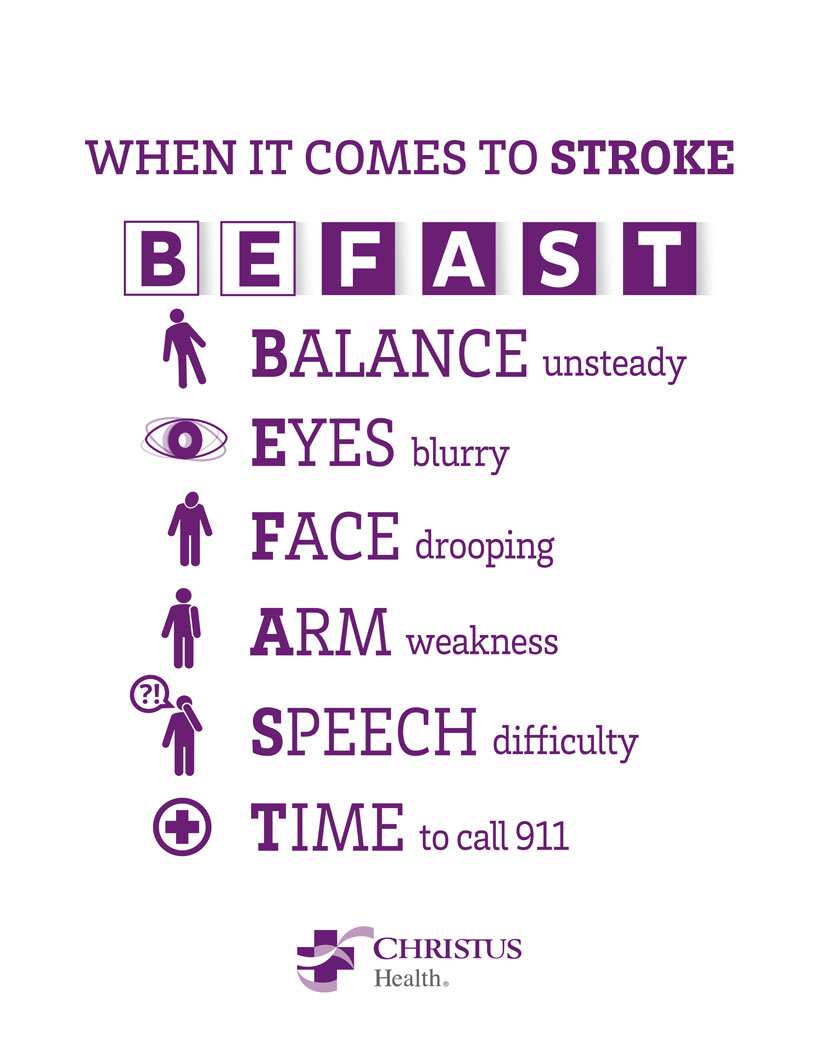Emergency Care During a Stroke
If you think you or someone you know is having a stroke, call 911 immediately or go the closest emergency room.
Find an Emergency RoomBE FAST: What are the Signs and Symptoms of a Stroke?
It is important to pay attention to the signs and symptoms of stroke because a person may have only a few minutes to receive treatment that can reduce the damage caused by the stroke and, in some instances, prevent death.
Time is of the essence when it comes to stroke, and prompt action can make all the difference. If treated quickly, someone who has suffered from a stroke can make a full recovery or significantly improve their post-stroke complications. Early recognition of stroke symptoms and getting medical help as soon as possible can lead to better outcomes.
Make sure that you and those around you are aware of the warning signs of a stroke, so you can take action when needed. Knowing the signs and symptoms may help you save a life – including your own.
Stroke Signs and Symptoms
During a stroke, the oxygen supply to the brain is interrupted, causing damage to the brain tissue. The signs and symptoms of stroke can vary depending on the part of the brain that is affected, which dictates which functions are disrupted.
Some of the most common signs and symptoms of stroke include:
- Sudden numbness or weakness in the face, arm, or leg on one side of your body
- Sudden confusion or trouble speaking or understanding others
- Sudden vision problems in one or both eyes
- Sudden dizziness, difficulty walking, or loss or lack of balance and coordination
- Severe headache with no known cause
- Fainting or unconsciousness
Learn More About Stroke Care
B.E.F.A.S.T
B.E.F.A.S.T is used to help remember the signs of a stroke:
- B – Balance: Watch for a sudden loss of balance
- E – Eyes: Check for vision loss
- F - Face Drooping: One side of the face may droop or become numb
- A - Arm Weakness: One arm may have weakness or numbness
- S – Speech Difficulty: Slurred or garbled speech, or the inability to talk
- T – Time to Call 911: A person needs to call 911 and get help immediately because time is critical.
Strokes are medical emergencies and time is of the essence when it comes to treatment. The faster you act, the more likely it is that the person will have a positive outcome.

Who is Most Likely at Risk of Having a Stroke?
Anyone can be at risk of having a stroke, but people with the following characteristics have a higher risk:
- People aged 55 years or older
- Male
- African American
The following conditions and lifestyle choices can also increase the chances of having a stroke. It is important to be aware of your risks and take steps to reduce it if possible.
- High blood pressure/hypertension
- Diabetes
- Coronary Artery Disease (CAD)
- Family history of stroke
- Obesity
- Smoking
- Sedentary lifestyle
- Excessive alcohol consumption
How are Strokes Diagnosed?
The diagnosis of a stroke typically requires a physical exam, laboratory tests, and diagnostic imaging.
Physical examination: A physical examination may include evaluating the patient’s ability to move or feel on one side of the body. They will also check for speech and language problems.
Laboratory tests: Laboratory tests check for abnormal blood clotting, cholesterol levels, and other signs of cardiovascular problems.
Diagnostic imaging: Diagnostic imaging tests such as computed tomography (CT) scans, and magnetic resonance imaging (MRI) can help determine the size, location, and extent of a stroke.
An angiogram may also be performed to examine blood vessels in the brain more closely. This is done if the cause is not clear.
Different Types of Strokes
The different types of strokes include ischemic stroke, hemorrhagic stroke, transient ischemic attack (TIA), and subarachnoid hemorrhage.
Ischemic stroke: Ischemic stroke occurs when an artery supplying blood to the brain becomes blocked by a blood clot or other material. This causes a lack of oxygen to the brain, leading to cell damage or death.
Hemorrhagic stroke: Hemorrhagic stroke happens when a weakened artery in the brain bursts and bleeds into the surrounding tissues. This can lead to severe brain damage and even death.
Transient ischemic attack: Transient ischemic attack (TIA) is also known as a “mini-stroke” and occurs when there is a temporary blockage of a blood supply vessel in the brain. Symptoms usually last for less than an hour and typically resolve on their own. TIA can be a warning sign of a stroke occurring in the future.
Subarachnoid hemorrhage: Subarachnoid hemorrhage is a type of stroke caused by bleeding in the area around the brain. This stroke is usually caused by a ruptured aneurysm. It can also be caused by other conditions such as high blood pressure or head trauma. It is a serious type of stroke and requires immediate medical attention.
How can a Person Prevent a Stroke?
The best way to prevent a stroke is to adopt a healthy lifestyle. This includes:
- Eating a balanced diet
- Exercising regularly
- Avoiding smoking
- Avoiding excessive amounts of alcohol
- Controlling high blood pressure, diabetes, and high cholesterol
- Managing stress levels
It’s also important to get regular check-ups with your doctor and to be aware of any family history of stroke or cardiovascular disease.
If you have any risk factors for stroke, it’s important to talk with your healthcare provider about how to reduce those risks. Schedule an appointment with your healthcare provider today.
Check Your Risk For Stroke
Complete the CHRISTUS Health Stroke Assessment to receive a report with your stroke risk factors and tips on reducing those risks.
